| Governor General's Foot Guards | |
|---|---|
 | |
| Active | 1872–present |
| Country | Canada |
| Branch | Canadian Army |
| Type | Foot guards |
| Role | Light infantry |
| Size | Battalion |
| Part of | 33 Canadian Brigade Group |
| Garrison/HQ | Cartier Square Drill Hall, Ottawa, Ontario |
| Nickname(s) |
|
| Motto(s) | |
| March |
|
| Anniversaries |
|
| Engagements | |
| Battle honours | See list of battle honours |
| Website | Official website |
| Commanders | |
| Current commander | LCol Jamie Bell |
| Colonel-in-Chief | Vacant |
| Colonel of the Regiment | Mary Simon, Governor General of Canada |
| Regimental sergeant major | CWO Greg L. Witol |
| Insignia | |
| Headdress | Khaki beret |
The Governor General's Foot Guards (GGFG) is the senior reserve infantry regiment in the Canadian Army. Located in Ottawa at the Cartier Square Drill Hall, the regiment is a Primary Reserve infantry unit, and the members are part-time soldiers.
The GGFG are infantry reserve soldiers who train part-time and full-time for domestic operations and international missions. This involves training for domestic operations where the unit deployed members to help during a natural disaster or public emergency such as it did during the 1998 Ice Storm, flooding in 2017 and 2019, and during the COVID-19 pandemic in 2020. It also involves training for international operations and support to the Regular Force on operations in countries such as Afghanistan, Sudan, Iraq, Jordan, Egypt, Latvia, and Ukraine where troops from the regiment have deployed in recent years.
Members of the GGFG train part time between September and June, usually Tuesday evenings and one weekend a month. Between May and August, members can be employed full time in a variety of roles such as students or instructors on training courses, taking part in tasks such as the Ceremonial Guard, and attending field exercises.
The regiment also runs supplementary training programs such as the marksmanship program to improve shooting skills, and the leadership development training program to prepare soldiers to attend leadership courses. Additionally the regiment runs sports and fitness programs. The GGFG are also affiliated with 1st Battalion, The Royal Canadian Regiment (1 RCR) for reserve integration training.
The GGFG perpetuate the 2nd Canadian Battalion (Eastern Ontario Regiment), CEF, and 77th Battalion (Ottawa), CEF, from the First World War.[2]

Regimental structure
The regiment is composed of the following sub-units:
- Regimental Headquarters – Regimental Headquarters is responsible for the overall command, control, and administration of all members of the regiment.
- No. 1 Company (Rifle Company) – The rifle company conducts collective field training exercises to train soldiers to work together as a team across a range of tactical scenarios. Most of the trained soldiers in the regiment are part of the rifle company.
- No. 2 Company (Training Company) – The training company runs individual training courses so members can become qualified or complete specialized courses. It is composed of instructors and students taking part in individual training courses. New members of the regiment are members of the training company until they are fully trained.
- No. 3 Company (Combat Service Support) – The Support Company provides logistical support to the training being conducted by No. 1 and 2 Companies.
- GGFG Band – The regimental band is a brass-and-reed band that represents the regiment at performances around the city and beyond.
- Public Duties Company – Public Duties Company (PDC) plans and conducts the Ceremonial Guard during the summer months as well as supporting the governor general and Rideau Hall with ceremonial tasks throughout the year.
The regiment also supports the 2784 GGFG Army Cadets of the Royal Canadian Army Cadets.
The PDC, given the suspension of Ceremonial Guard activities owing to the COVID-19 pandemic since 2020, is ad interim the official guard of honour of the Canadian Armed Forces. This status will continue until the Guard's reconstitution.
Lineage

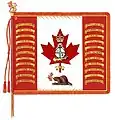 Regimental colour
Regimental colour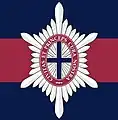 Camp flag
Camp flag
The GGFG originated in Ottawa, Ontario, on 7 June 1872 as the 1st Battalion Governor General's Foot Guards. It was redesignated as the Governor General's Foot Guards on 16 September 1887; as The Governor General's Foot Guards on 1 April 1896; as the 2nd (Reserve) Battalion, The Governor General's Foot Guards on 7 November 1941; as The Governor General's Foot Guards on 31 January 1946; as The Governor General's Foot Guards (5th Battalion, The Canadian Guards) on 1 September 1954; as the Governor General's Foot Guards (5th Battalion, The Canadian Guards) on 25 April 1958; and finally returned to the name Governor General's Foot Guards on 1 September 1976.[2]
In the Canadian Forces, units may make formal, official links between each other called affiliations. These affiliations are "to foster continuous fraternal connections between military organizations beyond the close, professional relationships which are always encouraged."[3] The GGFG were affiliated with the Canadian Guards, and from 1954 to 1976 they used a Canadian Guards battalion number in token of the affiliation. Despite the battalion number, the GGFG were considered a separate regiment from the Canadian Guards. The affiliation automatically ceased when the Canadian Guards were put on the Supplementary Order of Battle in 1970.[4]
| Lineage chart[5] | ||||||||||||||||||||||||||||||||||||||||||||||||||||||||||||||||||||||||||||||||||||||||||||||||||||||||||||||||||||||||||||||||||||||||||||||||||||||||||||||||||||||||||||||||||||||||||||||||||||||||||||||||||||||||||||||||||||||||||||||||||||||||||||||||||||||||||||||||||||||||||||||||||||||||||||||||||||||||||||||||||||||||||||||||||||||||||||||||||||||||||||||||||||||||||||||||||||||||||||||||||||||||||||||||||||||||||||||||||||||||||||||||||||||||||||||||||||||||||||||||||||||||||||||||||||||||||||||||||||||||||||||||||||||||||||||||||||||||||||||||||||||||||||||||||||||||||||||||||||||||||||||||||||||||||||||||||||||||||||||||
|---|---|---|---|---|---|---|---|---|---|---|---|---|---|---|---|---|---|---|---|---|---|---|---|---|---|---|---|---|---|---|---|---|---|---|---|---|---|---|---|---|---|---|---|---|---|---|---|---|---|---|---|---|---|---|---|---|---|---|---|---|---|---|---|---|---|---|---|---|---|---|---|---|---|---|---|---|---|---|---|---|---|---|---|---|---|---|---|---|---|---|---|---|---|---|---|---|---|---|---|---|---|---|---|---|---|---|---|---|---|---|---|---|---|---|---|---|---|---|---|---|---|---|---|---|---|---|---|---|---|---|---|---|---|---|---|---|---|---|---|---|---|---|---|---|---|---|---|---|---|---|---|---|---|---|---|---|---|---|---|---|---|---|---|---|---|---|---|---|---|---|---|---|---|---|---|---|---|---|---|---|---|---|---|---|---|---|---|---|---|---|---|---|---|---|---|---|---|---|---|---|---|---|---|---|---|---|---|---|---|---|---|---|---|---|---|---|---|---|---|---|---|---|---|---|---|---|---|---|---|---|---|---|---|---|---|---|---|---|---|---|---|---|---|---|---|---|---|---|---|---|---|---|---|---|---|---|---|---|---|---|---|---|---|---|---|---|---|---|---|---|---|---|---|---|---|---|---|---|---|---|---|---|---|---|---|---|---|---|---|---|---|---|---|---|---|---|---|---|---|---|---|---|---|---|---|---|---|---|---|---|---|---|---|---|---|---|---|---|---|---|---|---|---|---|---|---|---|---|---|---|---|---|---|---|---|---|---|---|---|---|---|---|---|---|---|---|---|---|---|---|---|---|---|---|---|---|---|---|---|---|---|---|---|---|---|---|---|---|---|---|---|---|---|---|---|---|---|---|---|---|---|---|---|---|---|---|---|---|---|---|---|---|---|---|---|---|---|---|---|---|---|---|---|---|---|---|---|---|---|---|---|---|---|---|---|---|---|---|---|---|---|---|---|---|---|---|---|---|---|---|---|---|---|---|---|---|---|---|---|---|---|---|---|---|---|---|---|---|---|---|---|---|---|---|---|---|---|---|---|---|---|---|---|---|---|---|---|---|---|---|---|---|---|---|---|---|---|---|---|---|---|---|---|---|---|---|---|---|---|---|---|---|---|---|---|---|---|---|---|---|---|---|---|---|---|---|---|---|---|---|---|---|---|---|---|---|---|---|---|---|---|---|---|---|---|---|---|---|---|---|---|---|---|---|---|---|---|---|---|---|---|---|---|---|---|---|---|---|---|---|---|---|---|---|---|---|---|---|---|---|---|---|---|---|---|---|---|---|---|---|---|---|---|---|---|---|---|---|---|---|---|---|---|---|---|---|---|---|---|---|---|---|---|---|---|---|---|---|---|---|---|---|---|---|---|---|---|---|---|---|---|---|---|---|---|---|---|---|---|---|---|---|---|---|---|---|---|---|---|---|---|---|---|---|---|---|---|---|---|---|
| ||||||||||||||||||||||||||||||||||||||||||||||||||||||||||||||||||||||||||||||||||||||||||||||||||||||||||||||||||||||||||||||||||||||||||||||||||||||||||||||||||||||||||||||||||||||||||||||||||||||||||||||||||||||||||||||||||||||||||||||||||||||||||||||||||||||||||||||||||||||||||||||||||||||||||||||||||||||||||||||||||||||||||||||||||||||||||||||||||||||||||||||||||||||||||||||||||||||||||||||||||||||||||||||||||||||||||||||||||||||||||||||||||||||||||||||||||||||||||||||||||||||||||||||||||||||||||||||||||||||||||||||||||||||||||||||||||||||||||||||||||||||||||||||||||||||||||||||||||||||||||||||||||||||||||||||||||||||||||||||||
Operational history
Members of the Regiment took part in the Nile Expedition of 1884 and the following year provided a company of sharpshooters to the Battleford column during the North West Rebellion, where the Regiment suffered its first two casualties at the battle of Cut Knife Hill. The company was removed from active service on 24 July 1885.[2]
During the Boer war the regiment contributed volunteers for the various Canadian contingents, mainly the 2nd (Special Service) Battalion, Royal Canadian Regiment of Infantry.[2]
 GGFG, 1875
GGFG, 1875
The Great War
The GGFG perpetuates two battalions of the Canadian Expeditionary Force who took part in the First World War.
The 2nd Battalion (Eastern Ontario Regiment), CEF “The Iron Second”, which was a part of the 1st Infantry Brigade, 1st Canadian Division and saw continuous service on the Western front from 1915 to end of war in 1918. The 2nd Battalion also fought at the battles of Ypres, St. Julien, Festubert, Pozières, Vimy (1917), Arleux, Hill 70, Passchendaele, Amiens, and Canal du Nord, to name only a few. By the end of the war, 242 officers and 5,084 other ranks had fought with the battalion. Of those, 52 officers and 1,227 other ranks were killed.
The 77th Battalion (Ottawa), CEF was authorized on 10 July 1915 and embarked for Great Britain on 19 June 1916. It provided reinforcements for the Canadian Corps in the field until 22 September 1916, when its personnel were absorbed by the 47th Battalion (British Columbia), CEF and 73rd Battalion (Royal Highlanders of Canada), CEF and the battalion was disbanded.[2]
The honours and traditions of these battalions are perpetuated by the GGFG.
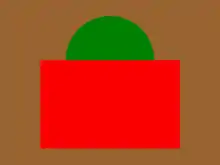 The distinguishing patch of the 2nd Battalion (Eastern Ontario Regiment), CEF.
The distinguishing patch of the 2nd Battalion (Eastern Ontario Regiment), CEF.
The Second World War
During the Second World War the GGFG was mobilized in May 1940. In 1942 the regiment was re-rolled to become an armoured unit to address the need for more armoured units in the Canadian Army, assuming the name “21st Canadian Armoured Regiment (G.G.F.G.)”. It embarked for Great Britain on 23 September 1942. On 24 July 1944, it landed in France as part of the 4th Armoured Brigade, 4th Canadian Armoured Division and it continued to fight in northwest Europe until the end of the war taking part in the battle of Normandy, the battle of the Scheldt, and the Rhineland. Over the course of the war the Regiment’s casualties were 101 dead and 284 wounded. The overseas regiment was disbanded on 31 January 1946.[2]
 Personnel from the GGFG with a Sherman tank, 1944
Personnel from the GGFG with a Sherman tank, 1944
Modern day
In the intervening years, members have participated in United Nations and NATO operations, including service in the Cyprus, Somalia, the Former Republic of Yugoslavia, Haiti, Ethiopia, and Sierra Leone. During the Canadian mission in Afghanistan, the GGFG deployed members, taking part Task Force 3-06, Task Force 3-08, and Task Force 1-10 in Kandahar, as well as the Operation Attention training mission in Kabul.
The GGFG provides individual augmentation to the Regular Force when they deploy on operations. The regiment deployed members on Operation Impact in Iraq and Jordan, Operation Calumet in Egypt, Operation Soprano in Sudan, Operation Reassurance in Poland and Latvia, and Operation Unifier in the Ukraine.
.jpg.webp)
The regiment maintains domestic response capability to support Canadians at home in natural disasters or emergencies. The regiment deployed soldiers to the 1998 Ice Storm, floods 2017 and 2019, and during the COVID-19 pandemic in 2020.
 GGFG soldiers on patrol in Kandahar as part of the 1 RCR Battle Group in 2010.
GGFG soldiers on patrol in Kandahar as part of the 1 RCR Battle Group in 2010. A GGFG soldier engaging a target during live fire training.
A GGFG soldier engaging a target during live fire training. GGFG soldiers on exercise in Petawawa.
GGFG soldiers on exercise in Petawawa.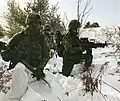 GGFG soldiers on a training exercise in Petawawa.
GGFG soldiers on a training exercise in Petawawa.
Victoria Cross recipients
| Recipient | Unit | Location | Date |
|---|---|---|---|
| (Acting) Corporal Leo Clarke[lower-alpha 2] | 2nd Battalion, Canadian Expeditionary Force | Pozières, France | September 9, 1916 |
| (Acting) Major Okill Massey Learmonth[lower-alpha 2] | 2nd Battalion, Canadian Expeditionary Force | Hill 70, France | August 18, 1917 |
Monuments
The No 1 Company Governor Generals Foot Guards and the Ladies Soldiers Aid Association of Ottawa erected a memorial tablet which was unveiled on May 2, 1887; The memorial is dedicated to the memory of Privates J. Rogers and Wm. B. Osgood who died in action at Cut Knife Hill on May 2, 1885, during the Northwest Rebellion.[6]
A memorial plaque in the GGFG Regimental Museum is dedicated to the memory of the 5326 Officers and Men who served in the 2nd Canadian Infantry Battalion Canadian Expeditionary force during the Great War 1914-1918.[7]
A Second World War–era Sherman tank nicknamed Forceful III in the Canadian War Museum, is dedicated to the memory of the members of the GGFG killed during the Second World War while operating as an armoured regiment.[8]
Lieutenant-colonels commanding
| No. | Name | Took office | Left office | Time in office (Years) | Governor general | Monarch |
|---|---|---|---|---|---|---|
| 1 | Thomas Ross | 18 Jun 1872 | 19 Nov 1886 | 14 | John Young, Frederick Hamilton-Temple-Blackwood, John Campbell, Henry Petty-Fitzmaurice | Queen Victoria |
| 2 | James Pennington MacPherson | 20 Nov 1886 | 23 Nov 1888 | 2 | Henry Petty-Fitzmaurice, Frederick Stanley | Queen Victoria |
| 3 | John Tilton | 24 Nov 1888 | 29 Nov 1889 | 1 | Frederick Stanley | Queen Victoria |
| 4 | Alfred Hamlyn | 30 Nov 1889 | 23 Mar 1892 | 2 | Frederick Stanley | Queen Victoria |
| 5 | Frederick Toller | 24 Mar 1892 | 24 Oct 1894 | 2 | Frederick Stanley, John Hamilton-Gordon | Queen Victoria |
| 6 | William Egerton Hodgins | 25 Oct 1894 | 27 Oct 1899 | 5 | John Hamilton-Gordon, Gilbert Elliot-Murray-Kynynmound | Queen Victoria / King Edward VII |
| 7 | Arthur Leonard Fitzgerald Jarvis | 28 Oct 1899 | 3 March 1904 | 4 | Gilbert Elliot-Murray-Kynynmound, Albert Grey | King Edward VII |
| 8 | Sydney Charles Dyne Roper | 4 Mar 1904 | 1 Apr 1906 | 2 | Albert Grey | King Edward VII |
| 9 | Henry Allan Bate | 2 Apr 1906 | 22 Mar 1908 | 1 | Albert Grey | King Edward VII |
| 10 | Douglas Richmond Street | 23 Mar 1908 | 19 Oct 1910 | 2 | Albert Grey | King Edward VII / King George V |
| 11 | James William Woods | 20 Oct 1910 | 7 Nov 1917 | 7 | Albert Grey, HRH Prince Arthur, Victor Cavendish | King George V |
| 12 | James Frederick Cunningham | 8 Nov 1917 | 3 May 1920 | 2 | Victor Cavendish | King George V |
| 13 | John Thomas Connelly Thompson | 4 May 1920 | 5 May 1921 | 1 | Victor Cavendish | King George V |
| 14 | William Bourbank Bartram | 6 May 1921 | 5 Oct 1921 | <1 | Victor Cavendish, Julian Byng | King George V |
| 15 | Richard Francis Parkinson | 6 Oct 1921 | 4 Oct 1925 | 3 | Julian Byng | King George V |
| 16 | Charles Beresford Topp | 5 Oct 1925 | 4 Apr 1930 | 4 | Julian Byng, Freeman Freeman-Thomas | King George V |
| 17 | James Cuvillier Foy | 5 Apr 1930 | 4 Apr 1934 | 3 | Freeman Freeman-Thomas, Vere Ponsonby | King George V |
| 18 | Geoffery Gordon Chrysler | 5 Apr 1934 | 4 Apr 1938 | 3 | Vere Ponsonby, John Buchan | King George V / King Edward VIII / King George VI |
| 19 | William Godfrey Hoffman Wurtele | 5 Apr 1938 | 25 Jan 1942 | 3 | John Buchan, Alexander Cambridge | King George VI |
| 20 | Howard Wilfred Rick | 26 Jan 1942 | 26 Aug 1943 | 1 | Alexander Cambridge | King George VI |
| 21 | Murray Joseph Scott | 27 Aug 1943 | 14 Aug 1944 | <1 | Alexander Cambridge | King George VI |
| 22 | Harold Foster Baker | 15 Aug 1944 | 17 Aug 1944 | <1 | Alexander Cambridge | King George VI |
| 23 | Edward Marshall Smith | 18 Aug 1944 | 1 Sep 1945 | 1 | Alexander Cambridge | King George VI |
| 24 | George Taylor Baylay | 2 Sep 1945 | 19 Feb 1946 | <1 | Alexander Cambridge | King George VI |
| 25 | Percy Hannaford | 20 Feb 1946 | 2 Jan 1947 | <1 | Alexander Cambridge, Harold Alexander | King George VI |
| 26 | Herschell Allistar Smith | 3 Jan 1947 | 3 Jan 1948 | 1 | Harold Alexander | King George VI |
| 27 | George Patrick | 4 Jan 1948 | 19 Aug 1952 | 4 | Harold Alexander | King George VI / Queen Elizabeth II |
| 28 | Thomas Guy Bowie | 20 Aug 1952 | 11 Nov 1957 | 5 | Harold Alexander, Vincent Massey | Queen Elizabeth II |
| 29 | George Galt Aldous | 12 Nov 1957 | 31 Jan 1960 | 2 | Vincent Massey, Georges Vanier | Queen Elizabeth II |
| 30 | Charles Douglas Arthur | 1 Feb 1960 | 13 Oct 1964 | 4 | Georges Vanier | Queen Elizabeth II |
| 31 | Ian Albert Hodson | 14 Oct 1964 | 14 Jul 1967 | 2 | Georges Vanier, Roland Michener | Queen Elizabeth II |
| 32 | David Phillip William Wood | 15 Jul 1967 | 29 Aug 1970 | 3 | Roland Michener | Queen Elizabeth II |
| 33 | Howard Rodney Hill | 30 Aug 1970 | 23 Sep 1973 | 3 | Roland Michener | Queen Elizabeth II |
| 34 | Roy Longbottom | 24 Sep 1973 | 17 Sep 1977 | 3 | Roland Michener, Jules Léger | Queen Elizabeth II |
| 35 | Michael Eric Butler | 18 Sep 1977 | 28 Jun 1980 | 2 | Jules Léger, Edward Schreyer | Queen Elizabeth II |
| 36 | Paul Stanley Dunseath | 29 Jun 1980 | 15 Jul 1984 | 4 | Edward Schreyer, Jeanne Sauvé | Queen Elizabeth II |
| 37 | Lawrence Edward Lomas | 16 Jul 1984 | 17 Jul 1988 | 4 | Jeanne Sauvé | Queen Elizabeth II |
| 38 | J.A.E. Michel Simard | 18 Jul 1988 | 30 Sep 1991 | 3 | Jeanne Sauvé, Ray Hnatyshyn | Queen Elizabeth II |
| 39 | Donald Ian MacLeod | 1 Oct 1991 | 17 Aug 1994 | 2 | Ray Hnatyshyn | Queen Elizabeth II |
| 40 | Lawson Roy Hillier | 18 Aug 1994 | 26 Jul 1997 | 2 | Ray Hnatyshyn, Roméo LeBlanc | Queen Elizabeth II |
| 41 | William Scott Sturgess | 27 Jul 1997 | 14 Jul 2000 | 2 | Roméo LeBlanc, Adrienne Clarkson | Queen Elizabeth II |
| 42 | Stephen John Delaney | 15 Jul 2000 | 27 Sep 2003 | 3 | Adrienne Clarkson | Queen Elizabeth II |
| 43 | Nicholas Curcumelli-Rodostamo | 28 Sep 2003 | 9 Sep 2006 | 2 | Adrienne Clarkson, Michaëlle Jean | Queen Elizabeth II |
| 44 | Robert Michael Foster | 10 Sep 2006 | 22 Sep 2009 | 3 | Michaëlle Jean | Queen Elizabeth II |
| 45 | Derek Joseph Cheff | 22 Sep 2009 | 16 Oct 2012 | 3 | Michaëlle Jean, David Johnston | Queen Elizabeth II |
| 46 | Kevin MacLean | 17 Oct 2012 | 29 Sept 2015 | 2 | David Johnston | Queen Elizabeth II |
| 47 | Chris Lynam | 30 Sept 2015 | 29 Oct 2019 | 4 | David Johnston, Julie Payette | Queen Elizabeth II |
| 48 | Vincent Quesnel | 30 Oct 2019 | 30 May
2023 |
4 | Julie Payette, Mary Simon | Queen Elizabeth II / King Charles III |
| 49 | Jamie Bell | 30 May
2023 |
Present | Mary Simon | King Charles III |
Alliances
Battle honours
- North West Canada, 1885[1]
- South Africa 1899–1900
- World War I: Ypres 1915, 1917, Flers-Courcelette, Passchendaele, Gravenstafel, Ancre Heights, Amiens, St. Julien, Arras 1917, 1918, Drocourt-Queant, Festubert, 1915, Vimy 1917, Hindenburg Line, Mount Sorrel, Arleux, Canal du Nord, Somme, 1916, Scarpe, 1917–18, Pursuit to Mons, Pozières, Hill 70, France and Flanders 1915–18
- World War II: The Hochwald, The Rhineland, Chambois, Falaise, Veen, The Scheldt, Falaise Road, Bad Zwichenahn, The Lower Maas, The Laison, North West Europe 1944-1945
- Afghanistan[10]
Rank names
- Ensign
- Second lieutenants (OF-1) in Guard regiments are referred by their former title of ensign (Esgn). The name derives from the task the newest joined officers were entrusted with, carrying the ensign or colours.
- Colour sergeant
- Personnel carrying the rank of warrant officer (OR-7) in Guard regiments are called by their former title of colour sergeant (CSgt). This rank originated from the appointment of specific sergeants to escort and defend the colours. Lower ranks refer to colour sergeants as "Sir" or "Ma'am" rather than "Warrant" as in other units.
- Guardsman
- Upon successful completion of recruit training soldiers are addressed as guardsman (Gdsm/OR-3). King George V awarded this honour in 1918 to mark the service of regiments of Foot Guards during the First World War. General Order 138 of 1928 promulgates this honour.
- Musician
- Upon successful completion of recruit training members of the band are addressed as musician (Muscn/OR-3).
 Viscount Willingdon inspecting the GGFG, 1927
Viscount Willingdon inspecting the GGFG, 1927.jpeg.webp) Members of the GGFG in their winter uniform, Remembrance Day 2017.
Members of the GGFG in their winter uniform, Remembrance Day 2017..jpg.webp) The Duke and Duchess of Cambridge inspecting the Governor General's Foot Guards
The Duke and Duchess of Cambridge inspecting the Governor General's Foot Guards The President of Italy Sergio Mattarella inspects an honour guard of the GGFG during his visit to Rideau Hall.
The President of Italy Sergio Mattarella inspects an honour guard of the GGFG during his visit to Rideau Hall.
Regimental museum
| Location | Cartier Square Drill Hall Ottawa, Ontario |
|---|---|
| Type | Regimental museum |
The Governor General's Foot Guards Regimental Museum collects, preserves, studies and exhibits those objects that serve to illustrate the history and traditions of the regiment. The museum will collect materials that depict the regiment’s past in terms of war, ceremonial, training, sport and other affairs that have influenced the regiment over the years. The museum will provide for the preservation of such material and for its availability to all those who wish to see and study it. The museum will be a non-profit educational establishment, operated for the regiment and open to the public, regardless of race, creed, or occupation. The museum will disseminate knowledge and stimulate interest through materials, information services by holding meetings and arranging special programs for the regiment, the association and the public for the furtherance of the purpose of the museum. The museum co-operates with the regiment, association, the National War Museum and other museums as well as the Municipality of Ottawa-Carleton, to collect and preserve materials of significance so that these materials may be preserved and aid in the advancement of knowledge of the regiment.[11] The Guards' museum holds many artifacts from throughout the history of the regiment. Some of the artifacts displayed are a captured German trench periscope, various firearms from past wars including a Second World War–era German MG42, a MP 40, and a copy of Mein Kampf signed by Adolf Hitler. Also on display are several books containing photographs from World War II. The museum is located in the south end of the Cartier Square Drill Hall and is open on parade nights or by appointment.
Order of precedence
Freedoms
The regiment has received the Freedom twice throughout its history at the following occasions:
Badge and motto
 |
|
Drill Hall
| Site | Date(s) | Designated | Location | Description | Image |
|---|---|---|---|---|---|
| Cartier Square Drill Hall | 1879 | Classified - 1985 Register of the Government of Canada Heritage Buildings | On the bank of the Rideau Canal, just south of Laurier Avenue W.
Ottawa, Ontario |
A large and centrally-located building with low-pitched gable roof houses The Cameron Highlanders of Ottawa (Duke of Edinburgh's Own) and GGFG and 2784 Governor General's Foot Guards Army Cadets | 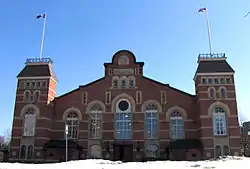 |
See also
References
- 1 2 3 4 "The official lineage of the Governor General's Foot Guards infantry regiment". Canadian Armed Forces. 24 October 2018. Retrieved November 8, 2021.
- 1 2 3 4 5 6 Department of National Defence. Insignia and Lineages of the Canadian Forces. Vol. 3: Combat Arms Regiments. Ottawa: Queen's Printer for Canada. Canadian Forces Publication A-DH-267-003.
- ↑ The Heritage Structure of the Canadian Forces. Directorate of History and Heritage. 4 January 1999. pp. 8–1.
- ↑ The Heritage Structure of the Canadian Forces. Directorate of History and Heritage. 4 January 1999. pp. 8–4.
- ↑ "Governor General's Foot Guards". www.canada.ca. 2018-10-24. Retrieved 2022-01-11.
- ↑ "Rogers and Osgood memorial (brass plaque): Cartier Square Drill Hall: Memorial 35059-090 Ottawa, ON". National Inventory of Canadian Military Memorials. Veterans Affairs Canada. Retrieved 31 December 2016.
- ↑ "2nd Canadian Infantry Battalion (First World War): Cartier Square Drill Hall: Memorial 35059-091 Ottawa, ON". National Inventory of Canadian Military Memorials. Veterans Affairs Canada. Retrieved 31 December 2016.
- ↑ "Forceful III: Canadian War Museum: Memorial 35059-011 Ottawa, ON". National Inventory of Canadian Military Memorials. Veterans Affairs Canada. Retrieved 31 December 2016.
- ↑ Steady the buttons two by two : Governor General's Foot Guards regimental history, 125th anniversary, 1872-1997. R. M. Foster, Tim Richter. Ottawa: Governor General's Foot Guards. 1999. ISBN 0968379206. OCLC 39347863.
{{cite book}}: CS1 maint: others (link) - ↑ "South-West Asia Theatre Honours". Office of the Prime Minister of Canada. Archived from the original on 12 May 2014. Retrieved 11 May 2014.
- ↑ A-AD-266-000/AG-001 Canadian Forces Museums – Operations and Administration 2002-04-03
- ↑ Dept, Innovative Client Services (2022-06-02). "Witness the Governor General's Foot Guards exercise Freedom of the City". ottawa.ca. Retrieved 2022-06-19.
- ↑ "GG's Foot Guards mark 150th anniversary with Freedom of the City march". ottawacitizen. Retrieved 2022-06-19.
- ↑ "Governor General's Foot Guards celebrate 150 years in Ottawa". Ottawa. 2022-06-04. Retrieved 2022-06-19.
- ↑ "Confirmation of the blazon of a Badge". Public Register of Arms, Flags and Badges of Canada. Official website of the Governor General. Retrieved November 8, 2021.
Further reading
- Governor General's Foot Guards (1947). Governor General's Foot Guards: Seventy-Fifth Anniversary, June 8, 1872-1947. Ottawa.
{{cite book}}: CS1 maint: location missing publisher (link) - Governor General's Foot Guards (1 January 1948). The Regimental History of the Governor General's Foot Guards: 1872-1946.
- Captain Robert M. Foster, CD (1999). Steady the Buttons Two By Two: Governor General's Foot Guards Regimental History, 125th Anniversary. Foster.
- Ducimus, The Regiments of the Canadian Infantry. St. Hubert: Mobile Command Headquarters, Canadian Armed Forces. 1992. p. 248. ISBN 0-9696421-0-5.